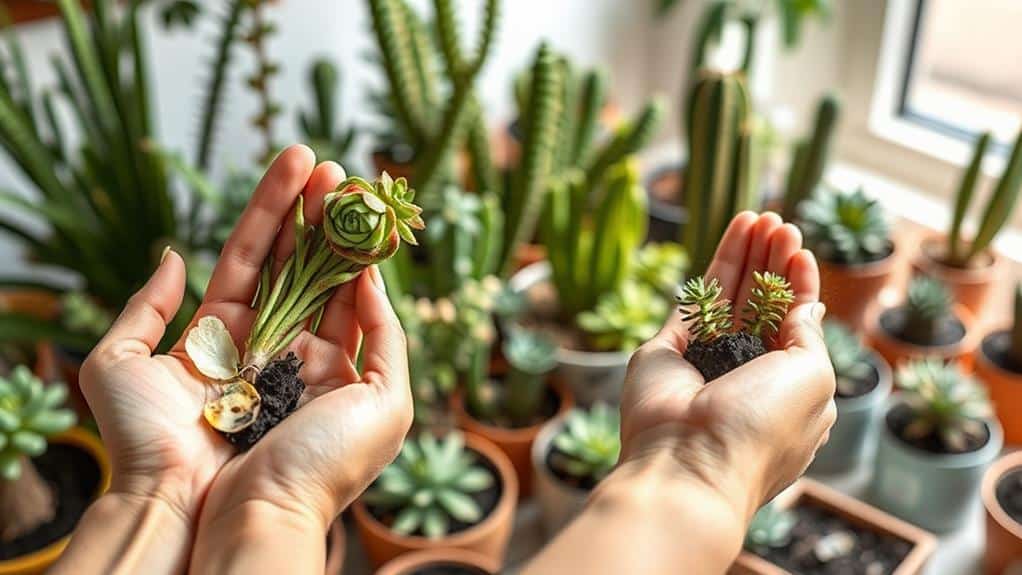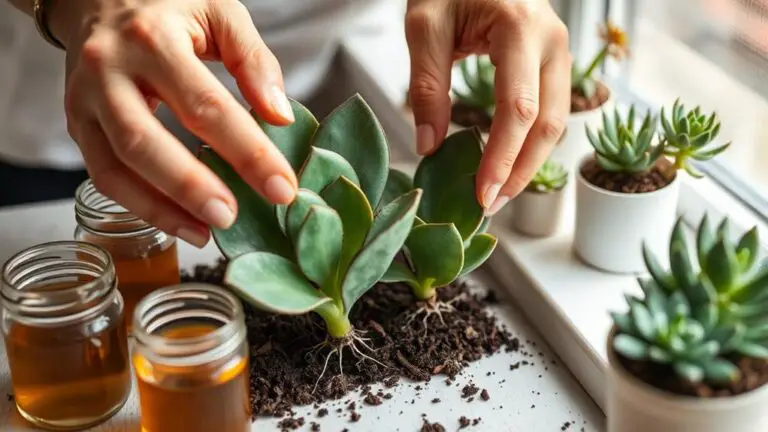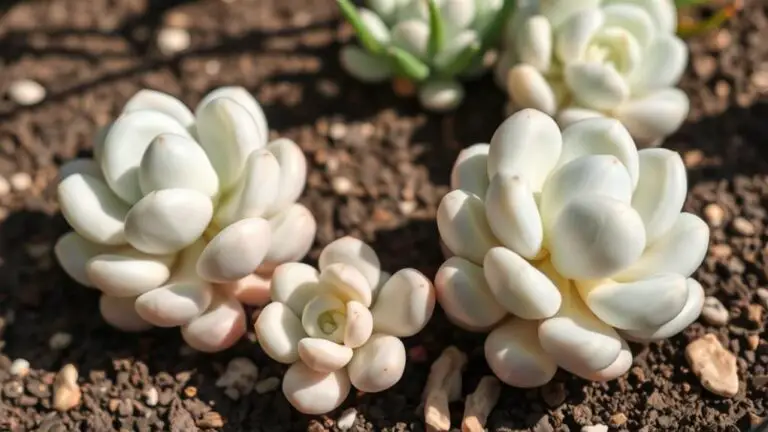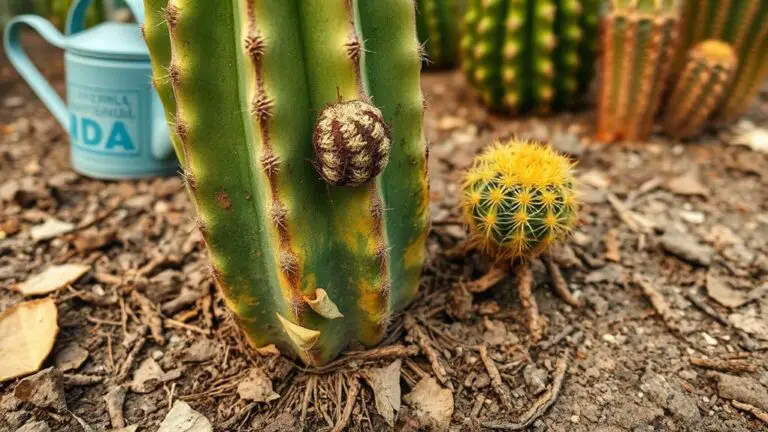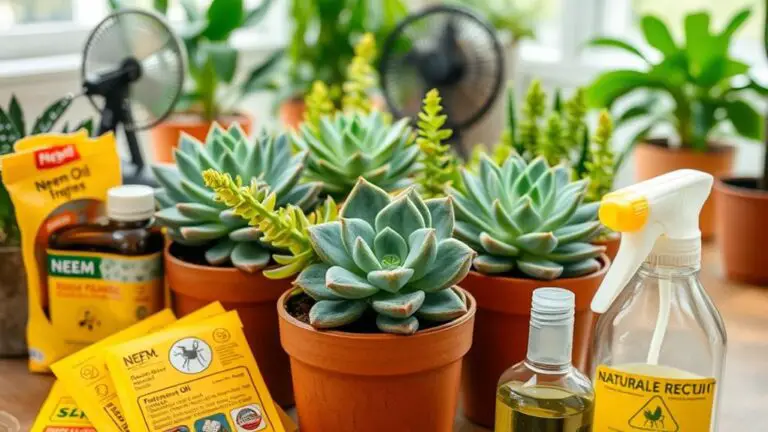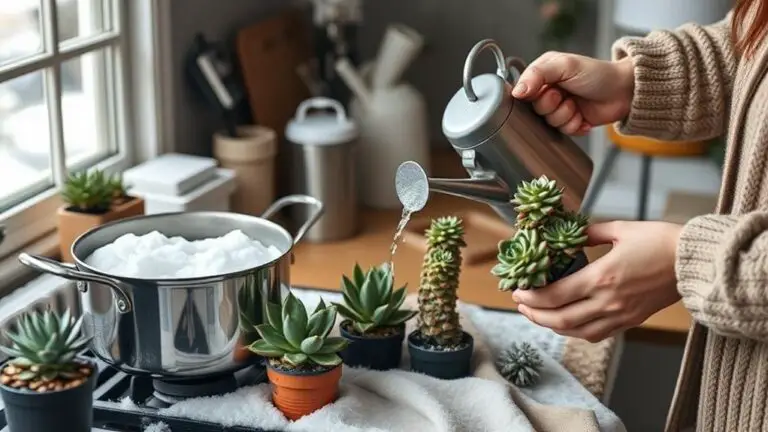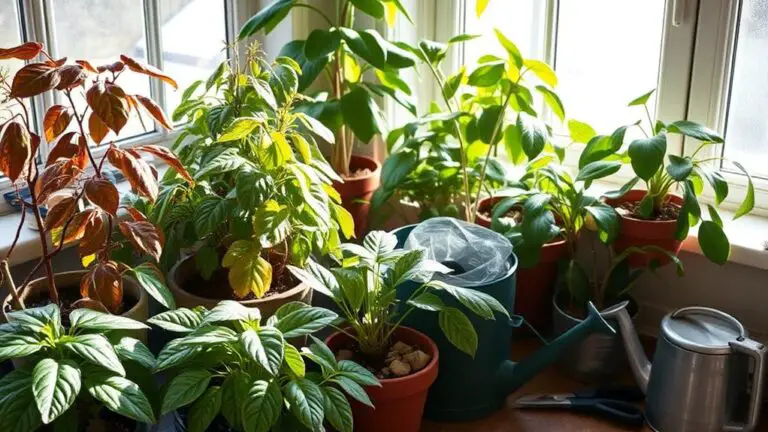7 Simple Steps to Propagate Your Succulents From Cuttings
If you've ever admired the beauty and resilience of succulents, you might've wondered how to multiply your collection without constantly buying new plants. Propagating succulents from cuttings is a straightforward process that you can easily master. First, you'll need to select the right cuttings and allow them to callous properly. But that's just the beginning. How do you guarantee they thrive once planted? And what role does light and watering play in their growth? By understanding and following these seven simple steps, you'll soon see your cuttings transform into thriving new plants.
Select Healthy Cuttings

When you're propagating succulents, selecting healthy cuttings is essential for success. Start by choosing a healthy stem with several leaves. Make sure the stem is free from disease and pests. This will help your cuttings root successfully.
Use sharp, sterilized scissors to cut the stem at a 45-degree angle. It's best to cut above a leaf or at a new offshoot. This technique encourages new growth. Select cuttings that are at least 2-3 inches long. Longer cuttings generally have a better chance of developing roots.
Before you proceed, inspect the cut ends closely. Look for any signs of damage or rot. Only use cuttings with firm, plump tissue for the best results. Damaged or rotting parts can hinder the rooting process.
Aim to take your cuttings during the spring or summer. This is when succulents are in their active growth phase, which increases rooting success.
Allow Callousing
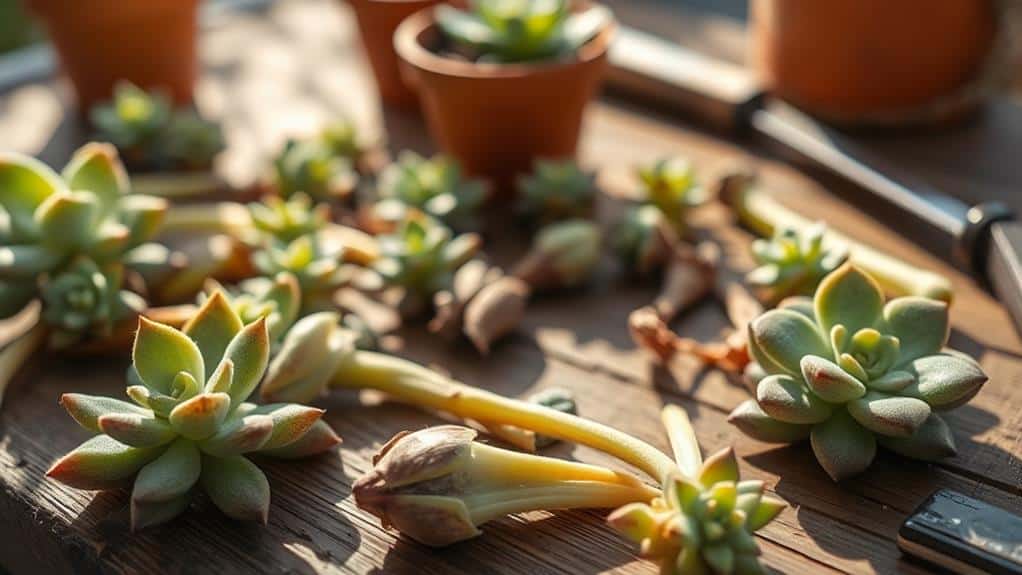
After you've taken your cuttings, it's important to let them dry and callous for 1-3 days.
This step is essential because the callousing process forms a protective layer over the cut end, preventing rot when you water them later.
Make certain to keep the cuttings in a warm, airy spot, away from direct sunlight, to guarantee they dry properly.
Why Callousing Matters
Allowing succulent cuttings to callous is vital for successful propagation. When you let the cut ends form a protective layer, you're setting the stage for healthy root development. Here's why callousing matters:
- Prevents Rot: By allowing cuttings to callous for 1-3 days, you prevent excess moisture from causing rot. This dry layer acts as a barrier, protecting the cut end.
- Reduces Infections: Callousing reduces the risk of fungal infections during the rooting process. A calloused end is less likely to harbor fungi that could harm your succulent.
- Improves Water Absorption: Once planted, a dry and calloused end enables better water absorption. This promotes healthier root development as the roots can effectively take in water without being overwhelmed.
- Encourages Root Formation: The callousing process encourages the formation of new root cells, which are essential for the cutting to establish itself in the soil.
Without proper callousing, the cutting might struggle to develop strong roots.
Ideal Drying Time
To guarantee your succulent cuttings thrive, give them 1-3 days to dry and callous before planting. This step is key because it helps form a protective scab over the cut end, reducing the risk of rot during initial watering. By allowing succulent cuttings to dry, you minimize moisture absorption at the cut site, which is essential for preventing the cutting from drowning once it's in the soil.
For thicker succulent stems, a longer callousing period, up to a week, might be necessary to make sure a proper seal forms. This extra time helps create a stronger protective scab, contributing to successful rooting and overall plant health.
During the callousing process, it's important to keep your cuttings in a warm, dry area with good airflow. Avoid places with high humidity, as excess moisture can hinder the drying process. Good airflow guarantees the cuttings dry evenly and quickly, achieving the ideal drying time.
Proper callousing is a critical step that greatly boosts the chances of your succulent cuttings rooting successfully. By following these steps, you're setting up your succulents for a healthy start and a bright future in your garden.
Prepare Well-Draining Soil
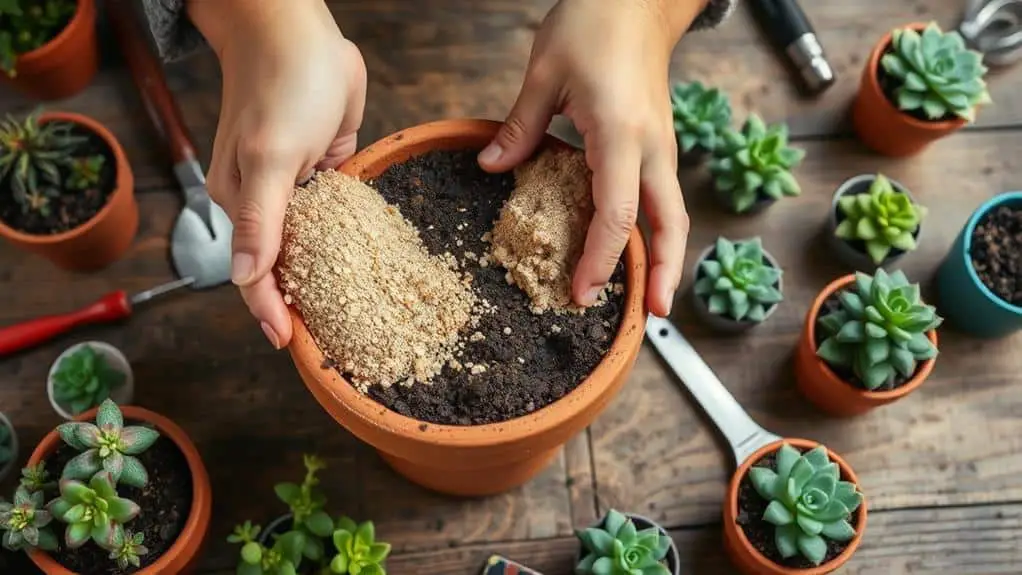
A well-draining soil mix is crucial for the health of your succulent cuttings, guaranteeing they don't succumb to root rot. When propagating succulents from leaves or cuttings, the right soil is fundamental for success.
Start by choosing a potting soil specifically designed for cacti and succulents, which has a gritty texture to promote proper drainage and aeration.
Here's a simple DIY soil mix you can make at home:
- 3 parts potting soil: This provides the base nutrients your cuttings will need as their roots begin to grow.
- 2 parts coarse sand: This guarantees the soil stays dry and prevents water from pooling around the roots.
- 1 part perlite or pumice: These materials help enhance drainage, making sure your succulents' roots get the air they need.
- A pot with drainage holes: Crucial for letting excess water escape, preventing root rot.
Fill your pot with the well-draining soil mix to about 2-3 inches below the rim.
Lightly compress the soil around your cuttings to keep them stable but not so tight that it hinders drainage.
With the right soil, your succulent cuttings are set for healthy growth!
Plant the Cuttings
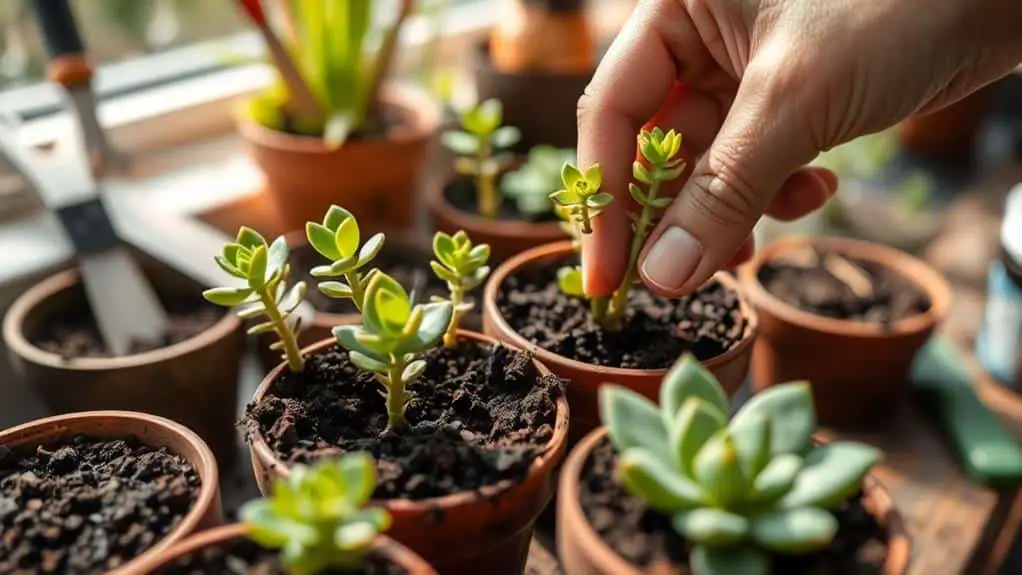
Once you've prepared the soil, it's important to plant the cuttings. Start by inserting the cut end of the succulent stem about 1-2 inches deep into the well-draining soil. Make sure it's stable and upright. To help the cutting absorb moisture efficiently, remove lower leaves from the stem. This keeps the leaves from being buried and prevents rot.
For rosette cuttings, you'll want to place them directly on top of the soil. This method helps prevent rot and encourages new growth. It's important to compress the soil lightly around the cutting. This step provides support and keeps the cutting from toppling over.
After planting, place the cuttings in bright indirect light. Avoid direct sunlight as it can dry them out, hindering healthy root development. Remember, the goal is to give your succulent cuttings the best environment to thrive.
Here's a quick summary table to help you:
| Step | Description |
|---|---|
| Depth | Insert cut end 1-2 inches deep into soil |
| Remove Lower Leaves | Expose the stem without burying leaves |
| Rosette Cuttings | Place directly on top of soil |
| Compress Soil | Lightly compress soil around cutting for support |
| Light | Keep cuttings in bright, indirect light to promote healthy root development |
Provide Optimal Light

To give your succulent cuttings the best start, make sure they get bright, indirect light.
Direct sunlight can dry them out and cause stress, so it's important to shield them during the propagation stage.
Position your cuttings near a window where they can soak up indirect sunlight for 6-8 hours a day, and rotate them occasionally to keep their growth even.
Indirect Sunlight Benefits
Indirect sunlight offers numerous benefits for propagating succulents from cuttings. This type of light provides a bright yet filtered environment, reducing the risk of leaf scorching and promoting healthier growth during the propagation process.
Placing your cuttings in a well-lit room with indirect sunlight helps them photosynthesize effectively without the stress of direct sun. This stable environment, with temperatures between 65-75°F, is ideal for root development.
Here are some key points to remember:
- Avoid Leaf Scorching: Indirect sunlight is gentle, preventing leaf burn that can occur with intense direct sunlight.
- Promote Root Development: The right amount of light and stable temperatures encourage the formation of strong roots.
- Effective Photosynthesis: Your succulents' cuttings will photosynthesize well without becoming leggy or dehydrated.
- Speed Up Rooting Process: Consistent indirect sunlight can accelerate the rooting process, often showing results within 2-4 weeks.
To achieve these benefits, place your cuttings near a window with sheer curtains or in any well-lit room. This setup guarantees they get enough light without exposure to harsh midday sun.
Avoid Direct Exposure
Shielding your succulent cuttings from direct exposure is vital for their successful propagation. Succulents thrive in bright, indirect light, which prevents them from becoming leggy and encourages healthy growth. Direct sunlight, especially during the initial propagation stages, can scorch the leaves, causing damage or even death to the cuttings.
To provide ideal light, position your propagated cuttings near a window with filtered light. Sheer curtains can help filter the intense rays, maintaining the right light levels while avoiding harsh sun. It's important to monitor the light exposure regularly, adjusting the placement of the cuttings as the seasons change to guarantee they receive adequate yet gentle light.
If you find that natural light is insufficient, consider using grow lights. These can provide the right spectrum for succulent growth without overwhelming the plants. Remember, the key is to avoid direct exposure and maintain a balanced light environment.
Here's a quick guide to help you manage light for your succulent cuttings:
| Situation | Action Needed |
|---|---|
| Direct sunlight | Move to a spot with indirect light |
| Insufficient natural light | Use grow lights |
| Changing seasons | Adjust placement as needed |
| Filtered light through curtains | Ideal for most cuttings |
Monitor Watering
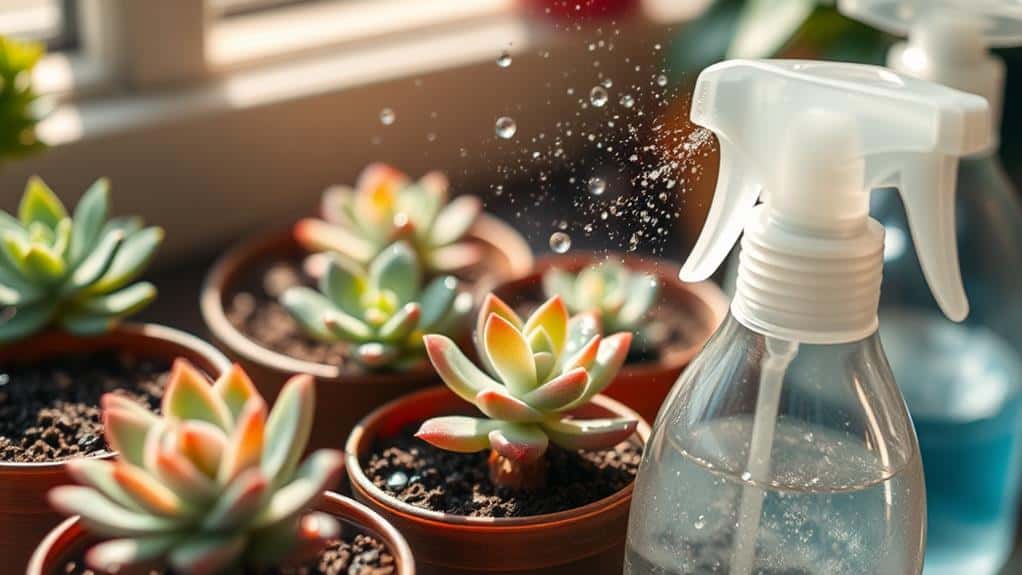
Monitoring watering is essential in the early stages of propagating succulents from cuttings. When you first plant your cuttings, water them sparingly, about 2-4 times per week.
Too much moisture can lead to rot before the roots have a chance to establish. Always let the soil dry out completely between waterings. Overwatering can turn your succulent leaves orangey-brown and may even kill the plant.
To keep an eye on the moisture level, use the finger test. Stick your finger into the soil up to the first knuckle; if it feels dry, it's time to water again.
Here's a quick guide to help you:
- Initial Watering: Water your new cuttings 2-4 times a week, allowing the soil to dry out completely between waterings.
- Moisture Check: Use the finger test to monitor soil moisture. If the top inch of soil is dry, water your cuttings.
- Root Establishment: After 4-6 weeks, gently pull on the cutting. If there's resistance, roots have formed.
- Adjust Watering: Once roots are established, water less frequently, around 2-4 times per month, ensuring the soil is fully dry between waterings.
Following these steps will help your succulents grow strong and healthy.
Watch for New Growth
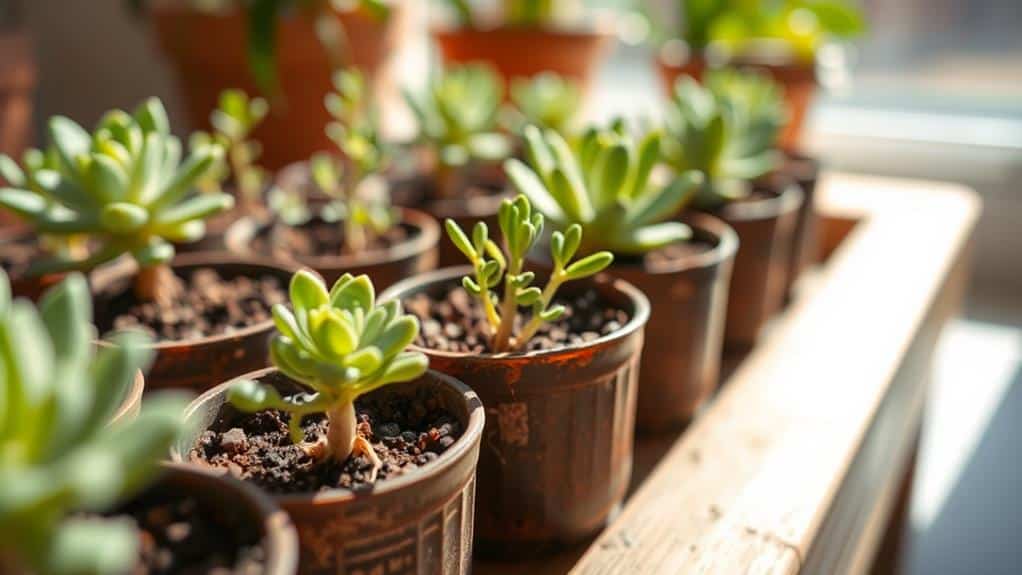
After planting your succulent cuttings, you'll typically see new growth within 2-4 weeks, signaling successful rooting and adaptation to the soil. This is an exciting time in your plant propagation journey.
You should monitor for rosettes forming above the soil surface. These small clusters show that your cuttings are absorbing nutrients and thriving.
Don't worry if the mother leaf or stem starts to shrivel and detach. This is a natural part of the process, indicating that the baby succulent is becoming self-sufficient.
When the new succulent reaches about an inch in size, consider repotting it to give it more space to grow.
Regularly check for roots by gently tugging on the cutting after 4-6 weeks. If you feel resistance, it means the roots have established well.
Healthy signs like plump leaves and visible new growth confirm that your efforts to propagate succulents are working.
Using rooting powder before planting your cuttings can speed up rooting and guarantee a higher success rate.
Frequently Asked Questions
How Do You Propagate Succulents for Beginners?
First, cut a healthy succulent stem at a 45-degree angle. Let it dry for a few days. Plant the calloused end in well-draining soil, water sparingly, and place in bright, indirect light. Monitor for growth.
Can You Put Succulent Cuttings Straight Into Soil?
You can put succulent cuttings straight into soil, but it's better to let the cut ends dry for 1-3 days first. This helps prevent rot and fungal infections. Use well-draining soil and water sparingly after planting.
How to Cut Succulent Stems and Replant?
To cut succulent stems, select a healthy stem and cut it at a 45-degree angle. Let the cut dry for 1-3 days, then plant it in well-draining soil. Water sparingly until roots develop in 2-4 weeks.
How to Root Succulent Cuttings in Water?
To root succulent cuttings in water, select healthy cuttings, let the ends dry for 1-3 days, and submerge only the cut end in water. Change the water every few days, and transfer to soil once roots develop.
Conclusion
You've got this! By following these steps, you'll successfully propagate your succulents and watch them thrive. Remember to select healthy cuttings, let them callous, and plant them in well-draining soil. Give them plenty of bright, indirect light and water just enough. Keep an eye out for new growth and use rooting powder if you like. Once they reach an inch, repot them. With a bit of patience and care, you'll soon have a beautiful collection of new succulents!

